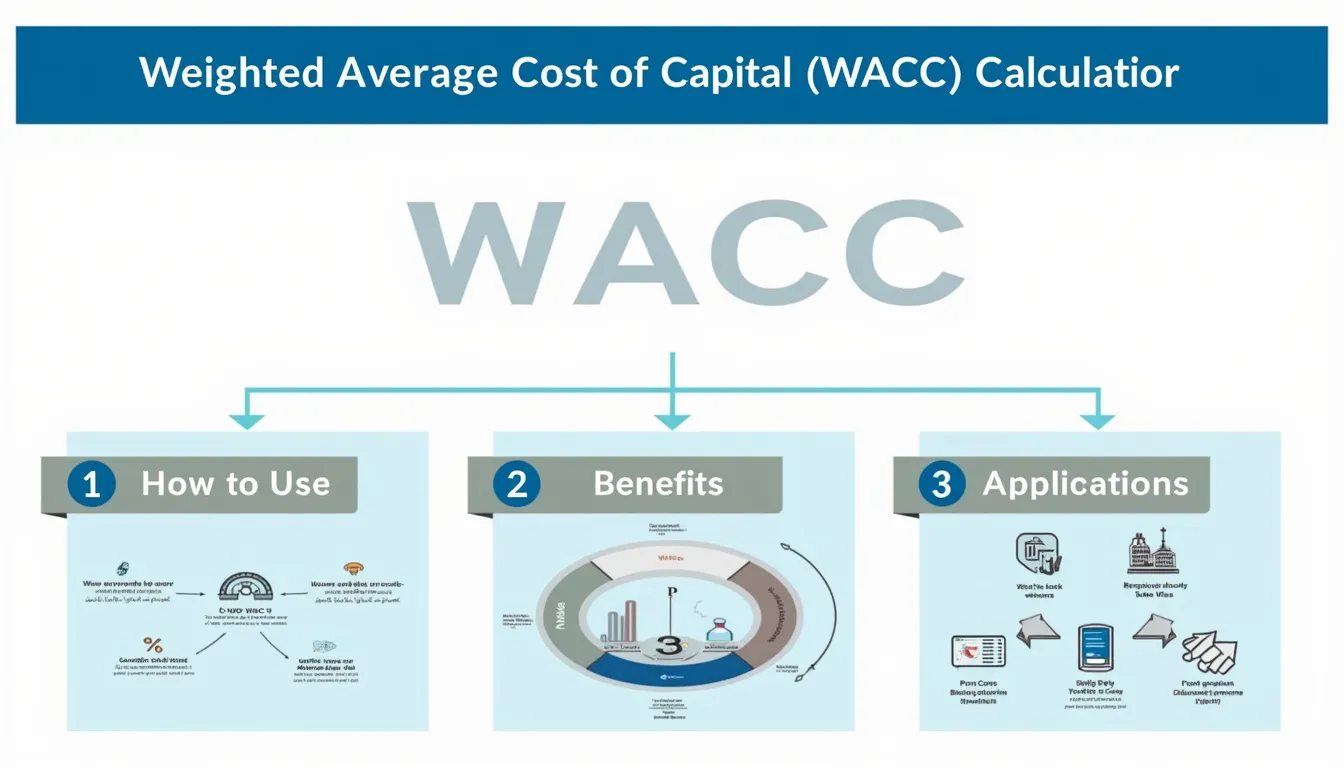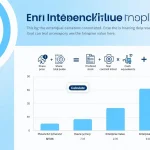Weighted Average Cost of Capital (WACC) Calculator
Is this tool helpful?
How to Use the Weighted Average Cost of Capital (WACC) Calculator Effectively
Our WACC Calculator allows you to efficiently determine your company’s overall cost of capital by entering a few key financial metrics. To get the most accurate and useful results, follow these simple steps:
- Enter the market value of your firm’s equity: Input the current market value of your company’s equity in USD. For example, enter 750,000,000 to represent $750 million.
- Input the market value of your firm’s debt: Provide the total market value of your company’s outstanding debt. A sample input could be 350,000,000 for $350 million.
- Specify the cost of equity (%): Enter the investor-required return on equity as a percentage. For instance, you might input 10.5 %.
- Provide the cost of debt (%): Input the interest rate your company pays on debt before taxes. Example value: 6.2 %.
- Include the corporate tax rate (%): Enter the applicable corporate income tax rate as a percentage, such as 28 %.
- Calculate and review: After filling in the fields, click the calculate button. The tool will instantly provide your company’s WACC expressed as a percentage, indicating your overall cost to finance assets.
Ensuring that each input is accurate and up-to-date will result in the most reliable Weighted Average Cost of Capital calculation for your business needs.
What is the Weighted Average Cost of Capital (WACC) and Why It Matters
The Weighted Average Cost of Capital (WACC) is a vital financial metric that measures the average cost a company incurs to finance its assets through a blend of equity and debt financing. It effectively captures the company’s required return from both shareholders and creditors, weighted by their respective contributions to the company’s capital structure.
Understanding WACC is essential because it:
- Helps evaluate new investment opportunities and capital projects
- Determines the minimum acceptable return for shareholders and lenders
- Guides strategic decisions on financing and capital structure optimization
- Serves as the discount rate in company valuation models
By calculating WACC, businesses ensure their investments generate returns above their overall cost of capital, creating value for shareholders.
The Weighted Average Cost of Capital Formula Explained
The formula for calculating WACC is:
$$ WACC = \frac{E}{V} \times R_e + \frac{D}{V} \times R_d \times (1 – T_c) $$
Where:
- E = Market value of the company’s equity
- D = Market value of the company’s debt
- V = Total market value of financing, V = E + D
- Re = Cost of equity (expressed as a decimal)
- Rd = Cost of debt (expressed as a decimal)
- Tc = Corporate tax rate (expressed as a decimal)
Example Calculation Using the WACC Calculator
Suppose a company has the following financial data:
- Market value of equity (E): $750 million
- Market value of debt (D): $350 million
- Cost of equity (Re): 10.5%
- Cost of debt (Rd): 6.2%
- Corporate tax rate (Tc): 28%
First, calculate the total value of the firm’s financing:
$$ V = E + D = 750,000,000 + 350,000,000 = 1,100,000,000 $$
Now, plug into the WACC formula:
$$ WACC = \frac{750,000,000}{1,100,000,000} \times 0.105 + \frac{350,000,000}{1,100,000,000} \times 0.062 \times (1 – 0.28) $$
Calculating each term:
- Equity portion: 0.6818 × 0.105 = 0.0716 (7.16%)
- Debt portion after tax: 0.3182 × 0.062 × 0.72 = 0.0142 (1.42%)
Adding both gives:
$$ WACC = 7.16\% + 1.42\% = 8.58\% $$
This means the firm’s average cost of capital is approximately 8.58%. Projects returning above this rate create shareholder value.
Why Use This Weighted Average Cost of Capital Calculator?
Our WACC Calculator is equipped to help investors, CFOs, financial analysts, and business owners:
- Save time: Calculate WACC instantly without manual errors.
- Enhance accuracy: Reduce common mistakes associated with complex financial formulas.
- User-friendly interface: Suitable for users with varying financial expertise.
- Scenario analysis: Test different capital structures and tax rates to optimize financing strategies.
- Strategic planning: Support data-driven investment and budgeting decisions.
- Risk evaluation: Understand the company’s financing risks and costs clearly.
Practical Applications of the WACC Calculator in Business
1. Evaluating Expansion Projects
Before funding a new product launch or expansion, companies can calculate their WACC to set a minimum acceptable rate of return. If the projected ROI surpasses the WACC, the project is likely value-adding.
2. Making Acquisition Decisions
Investors and corporate strategists use WACC to compare acquisition targets. A lower WACC indicates a cheaper cost of capital, making companies with low WACC more attractive targets.
3. Optimizing Capital Structure
By experimenting with different proportions of equity and debt inputs, businesses can identify the optimal blend that minimizes WACC, reducing their overall cost of financing and boosting profitability.
4. Enhancing Financial Valuation Models
Accurate WACC is a cornerstone of discounted cash flow (DCF) and other valuation models. Using this calculator ensures credibility in assessing company worth and investment decisions.
Frequently Asked Questions about the Weighted Average Cost of Capital
What does WACC represent in financial analysis?
WACC expresses the average rate that a company must pay to finance its assets through both equity and debt, reflecting the opportunity cost of capital for investors and lenders.
Why is understanding WACC crucial for businesses?
It functions as a benchmark for deciding whether to pursue new projects or investments and guides capital structure strategies to minimize financing costs.
Can the WACC Calculator be used for businesses of any size or industry?
Yes, this calculator is versatile and applies to small startups, large corporations, and across various industries seeking to know their cost of capital.
How often should WACC be recalculated?
It is best to recalculate WACC regularly, especially after significant changes in debt levels, equity financing, tax rates, or market conditions to maintain accurate financial assessments.
What are the limitations of WACC?
WACC assumes a stable capital structure and tax rate, and may not fully reflect project-specific risks or changing market dynamics. It should be used alongside other financial analyses.
Conclusion: Empower Your Financial Decisions with Precise WACC Calculations
Our Weighted Average Cost of Capital Calculator is an essential tool designed to help professionals and business owners alike gain clarity on their cost of capital. By providing reliable, instant calculations, this tool supports smarter decision-making in:
- Assessing viable investment opportunities with confidence
- Optimizing financial structures for reduced costs and increased value
- Improving accuracy in company valuation and budgeting
- Enhancing strategic financial planning for sustainable growth
Leverage this user-friendly WACC Calculator today to navigate the complexities of corporate finance easily and ensure your investments generate meaningful returns above your company’s cost of capital. Make informed choices that enhance shareholder value and secure your company’s financial future.
Important Disclaimer
The calculations, results, and content provided by our tools are not guaranteed to be accurate, complete, or reliable. Users are responsible for verifying and interpreting the results. Our content and tools may contain errors, biases, or inconsistencies. Do not enter personal data, sensitive information, or personally identifiable information in our web forms or tools. Such data entry violates our terms of service and may result in unauthorized disclosure to third parties. We reserve the right to save inputs and outputs from our tools for the purposes of error debugging, bias identification, and performance improvement. External companies providing AI models used in our tools may also save and process data in accordance with their own policies. By using our tools, you consent to this data collection and processing. We reserve the right to limit the usage of our tools based on current usability factors.







